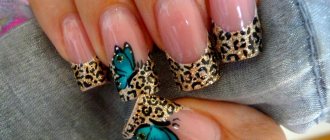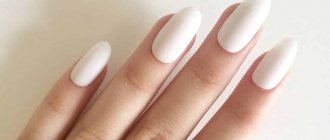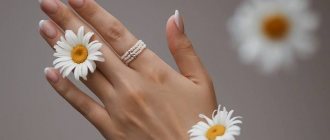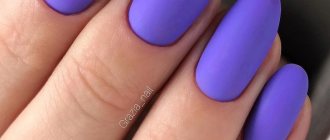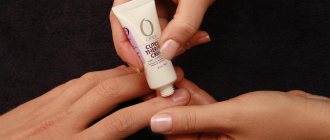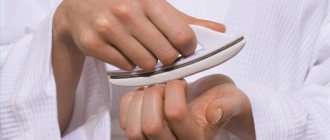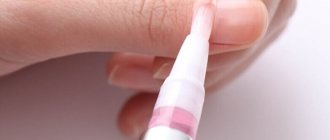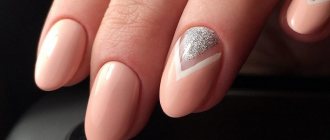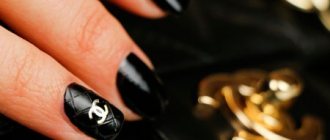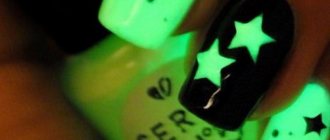The cuticle is the layer of overgrown skin at the base of the nail. For some it is a rather dense and evenly growing ridge, for others it is a thin film. Initially, this strip of skin protects the base of the nail bed from damage and infection. Therefore, you need to care for it competently. As the cuticle grows, it dries out and cracks.
For many, it consists of two layers: a film that fits tightly to the surface of the nail and a second layer of dermis that grows on top. It is very difficult to remove the film without preparing the nails for the procedure.
Women's hands look well-groomed only if their nails look beautiful: if they are smooth, have an even shade of color, and are neat. Carefully processed cuticles play a significant role in overall grooming.
There are different ways to remove cuticles at home. Choose yours:
- Hardware manicure. We described this method in detail in the article.
- European unedged manicure. This method is also described in a special article.
- Edged (classic) manicure. We will tell you more about it.
What is cuticle
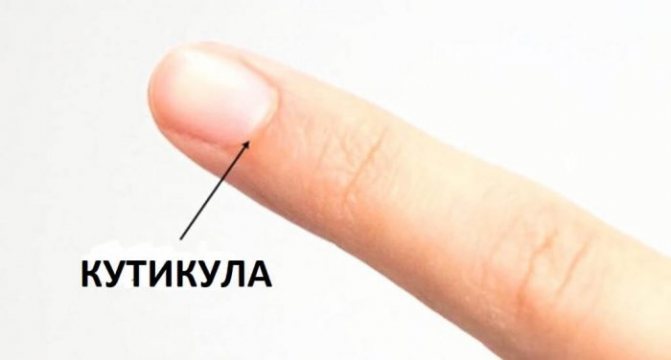
The cuticle is a protective leathery cushion that frames the base of the nail - the matrix. It serves as an obstacle to the penetration of bacteria and foreign bodies into the growth zone.
It consists of eponychium - the upper part, and pterygium - the lower layer, which grows to the nail plate and grows with it. How fast does the cuticle grow? A partial update lasts 14 days, and a full update lasts 21 days. It is within these time frames that it is recommended to perform hardware and trim manicures.
Nail structure and growth: what healthy nails and skin should look like, care rules
Why do you need to take care of your cuticle? Its edge is constantly growing and shedding dead dry cells. Over time, it peels off, cracks, tears, and causes burrs to appear. If an infection is added to this, reddish areas of inflammation appear.
To avoid this problem, it is necessary to take care of the cuticle and nails in a timely manner, take care of nourishing and moisturizing the skin, and remove keratinized dry edges. Let's take a closer look at the basic rules, procedures and cuticle care products. Everything must go together and be carried out systematically.
Practical advice
A few more tips on how to properly perform a manicure:
- Treat nails;
- Remove the excess layer without cutting the skin;
- Use nourishing cuticle gel after each treatment process;
- When not cutting a manicure, be sure to use a remover (cuticle), which softens and simplifies the process;
- Disinfect instruments;
- Use high-quality scissors, tweezers, files;
- You should not frequently coat your nails with varnish;
- It is necessary to file nails in a certain order without chaos;
- Cleaning the space under the plate requires a metal tool.
Experts require that you adhere to these rules to maintain the health and shape of your nails.
Simple recommendations on how to get rid of cuticles and properly care for your hands will help give your hands a well-groomed look. And your nails will look aesthetically pleasing even in the closest photo. The basic rule of every woman is to carry out procedures in a timely manner; you cannot be lazy if you want to look perfect from head to toe.
Care rules, materials and tools

A set of procedures aimed at caring for and maintaining the skin of the hands, cuticles and nails in a healthy and attractive state consists of the following stages:
- Cleansing;
- Hydration;
- Nutrition;
- Masks and wraps;
- Massage;
- Baths;
- Prevention of burrs;
- Measures to slow growth;
- Manicure: hardware, edged and European.
For care you will also need cosmetics, materials and tools, depending on the procedure being performed:
- Moisturizing and nourishing cream;
- Ready-made or homemade massage scrub;
- Paraffin for hot or cold treatments;
- Cuticle oil;
- Grooming pencils as an express method;
- Ready-made masks or ingredients for making at home;
- Ingredients for baths - soap, salt, iodine, aromatic oils, tinctures;
- Medicinal preparations for eliminating inflamed hangnails at home - ointment with silver, Solcoseryl gel, Spasatel balm, Sudocrem;
- Cuticle files - diamond, laser, ceramic;
- Orange sticks or pusher;
- Scissors or wire cutters.
Basic rules for removing cuticles
There are some recommendations for proper cuticle treatment that should be followed:
- The use of blades is prohibited;
- You cannot cut the skin very close to the base of the plate;
- It is imperative to disinfect instruments;
- The use of other people's devices is prohibited;
- The skin needs hydration after the procedure;
- Do not chew off hangnails or cuticles under any circumstances.
These are simple rules that will help maintain healthy and pleasant appearance of your hands.
Cleansing
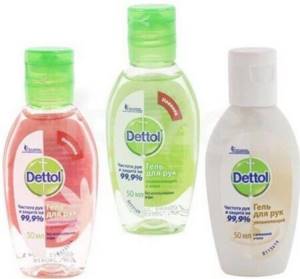
Before performing any procedures for caring for the skin of your hands, nails and cuticles, it is necessary to ensure their cleansing. Choose at your discretion:
- Wash your hands with soap or cleansing foam;
- Use a gel marked “soap-free”;
- Apply a gentle gel sanitizer;
- Treat with a disinfectant or antiseptic in the form of a gel or spray;
Soap and other cleansing cosmetics are best used with an optimal pH of 5.5. If water is used for cleansing, it should be warm to eliminate the stressful effects of temperature on the vessels and capillaries of the skin.
Antiseptics and disinfectants are used in the salon format, as they are more aggressive in their effects. Sanitizers are convenient for travel, for the office, and in other force majeure situations where there is no water to clean your hands and cuticles before applying skincare cosmetics or cream.
Brands of good cleansing products: antiseptics Teflex A, Desiptol, Bal Professional, Beautix, Dona Jerdona, RiO Profi, antiseptic oil for cuticles Patrisa Nail. The latter is suitable not only for cleansing and nutrition, but also for treating hangnails.
Combined manicure
It is a mix of hardware and trimming techniques. Most popular in salons, as it requires less time to perform. Performed on dry skin.
The cutters are used to clean the nail plate and process the side ridges, then the cuticle is cut with scissors or tweeters, after which the cut is sanded with a cutter.
*Scissors and tweeters in this technique are more convenient than nippers in that they allow you to cut the cuticle more safely due to the rounded blades.
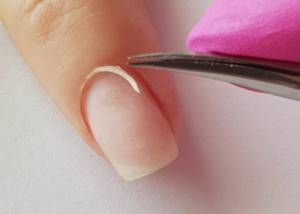
It should be noted that this type of manicure does not have the advantages of hardware in terms of atraumaticity, but it is convenient and fast for the master and the client. Also, some clients with sensitive cuticles find it difficult to cut cuticles with cutters due to their vibration and heating of the skin. In this case, they can be offered a combined manicure.
Both classic, hardware, and combined manicures allow you to do a fairly deep treatment with subsequent coating of the nails with gel polish “under the cuticle.” The only thing you need to remember when working with the “wet” method is that the steamed nail should be thoroughly dried before coating using a dehydrator. When using a cuticle remover, it must be carefully removed before coating - rinse off and wipe thoroughly with a napkin with a degreaser (Nail Prep).
Before modeling (extension) of nails, wet methods are not allowed; if there is no apparatus, then manicure is performed after extension.
Men's manicure
Can be made using any technique. The male epidermis is different from the female, therefore both the cuticle and nail plates are denser. The mechanical load on men's hands can be much greater, which is why hangnails are more common. Do not try too hard to thin the cuticle and side ridges - the body will respond with accelerated skin growth in areas of high stress.
Features of men's manicure
- The master should not go to a great depth in the proximal fold, because there is no need to do a deep manicure;
- the length of nails for men is always about 0.5 mm;
- The shape of the free edge is given “according to the shape of the cuticle,” that is, round.
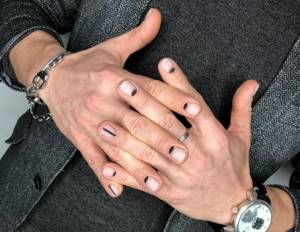
Before our eyes, gel polish coating is becoming popular among men. Some of them allow themselves a design with inscriptions and black matte gel polish at a minimum length. For the majority of our fellow citizens, this is still a cause of rejection, but it should be noted that such experiments are underway among the dudes and they look very relevant.
Hydration and nutrition
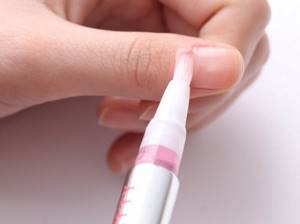
Part of the cuticle grows back already dry, as these are dead skin cells. Additionally, due to insufficient hydration, constant contact with detergents, dust, weather conditions, the skin of the hands dries out, and the cuticle can crack, tear and become inflamed when pathogenic microorganisms enter.
To avoid this, you need to take care of your nails and cuticles, constant hydration and nutrition, both with improvised and special cosmetics.
To do this, after each hand washing and contact with an aggressive environment, it is necessary to apply a moisturizing or nourishing cream. The choice of product depends on the season and the initial condition of the skin.
- You can use a moisturizer during the day, as it has a lighter texture, and at night be sure to apply a nourishing one, or make a mask under plastic. It is better to choose products that are recommended for caring for the skin of your hands and nails at the same time.
- The second option is cuticle oil. The oils, vitamins, minerals and active additives it contains provide multidirectional effects that combine hydration and nutrition at the same time. It is recommended to apply the oil 1-3 times a day after cleansing. 1 drop of the product is placed at the base of the nail, and then distributed with your finger along the entire perimeter of the cuticle.
What is the cuticle made of?
When performing a home manicure, you need to pay attention to the structural features of the element that rests on the surface of the nail, since it can be damaged if the equipment is not used correctly.
Typically, the structure of the cuticle and the degree of skin distribution depend on the genetic characteristics of a person, so it is practically impossible to change them, but you can maintain a neat condition by performing competent care. However, in men, the cuticle may be more noticeable, which is associated with an increased amount of male hormones responsible for the quality and quantity of hair, nails, and skin.
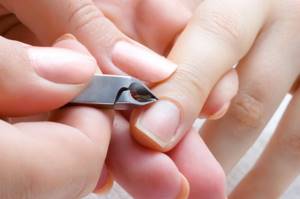
There are two main elements of the cuticle that can be separated:
- Pterygium. The lower part, which is located under the back cushion of the nail. It represents a thin film that forms on the nail. In men, it can occupy 30% of its entire surface.
- Eponychium. The visible part of keratinized skin that overlaps the nail bed and is located near the matrix - its base. Using classical technology, only the eponychium is removed, which prevents infection under the tissue.
The edges of the cuticle dry out and become keratinized, which can cause hangnails to form on the fingers. Typically, they appear in the absence of proper care of the hands and nail plates, and neglect to use rubber gloves when working with chemicals and aggressive components.
Since the eponychium is very thin, you need to pay attention to moisturizing and nourishing the skin of your hands so that your nails look neat and without trimming the manicure. The normal water balance of a healthy epidermis contributes to the formation of a uniform, small cuticle, which does not grow too much on the nail, but is located near the white hole, without overlapping it.
There are also two types of cuticles as they grow on the nail: internal and external. The first type implies the presence of a small “rim” of skin that fits the inner surface, and the second - a thin epidermis on the plate itself (it can reach up to a third of it), which is not very noticeable, but can be felt to the touch. Often girls at home push back the outer part themselves, making the nail smooth and even.
Ingredients of creams and oils
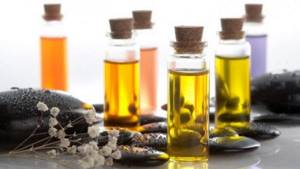
The following ingredients are found in the compositions of oils and creams:
- Hyaluronic acid . Able to absorb and store large amounts of moisture, activates the synthesis of collagen and elastin. The skin of the hands and cuticles are smoothed and receive intense hydration.
- Glycerin . Forms a film on the surface of the skin, retains moisture and protects the cuticle from drying out and splitting. Has softening properties.
- Vitamins A and E. Nourish, promote cell renewal, smooth the skin of the hands and cuticles. They are strong antioxidants that prevent wilting and aging.
- Beeswax . Forms a protective barrier, retains moisture, softens and activates metabolic processes.
- Essential and cosmetic oils . Dry and tired skin often lacks its own lipids, and it receives them thanks to the oils contained in cosmetics. They, in turn, contain amino acids, fatty acids, vitamins and microelements, which additionally nourish cells, restore and slow down the aging process.
- The most popular oils in hand creams and cuticle products are shea, peach, almond, rose, coconut, and lavender.
- Natural extracts, extracts of herbs and plants . Aloe vera is the most intense moisturizing component that can be found in hand care cosmetics. Along with it are cucumber and avocado. Chamomile and calendula have an antiseptic effect.
- Urea . It has an effective moisturizing effect and is a transport component for other cosmetic substances, delivering them to the deep layers of the skin. It has a beneficial effect on skin with dermatological problems, providing an anti-inflammatory and protective effect. It is also used in keratolytics, which contain from 10 to 30%.
§ 41. The meaning of skin and its structure
Remember
1 question
What body coverings are found in animals?
Answer:
The external integument of animals is represented by skin or integument. In invertebrates, the body covers are represented by ectoderm, in arthropods there is a chitinized cuticle and shell, in vertebrates there is skin with horny formations, feathers, and wool.
2. Question
What are the body coverings of mammals?
Answer:
The integument of the body of mammals is represented by skin. Surface mammals have fur on their skin; aquatic mammals have no fur.
1 question
Describe the significance of the skin.
Answer:
The skin has a protective function: it is strong, elastic, protects internal organs from mechanical damage (impacts, bruises) and from loss of water; Thanks to skin receptors we feel pain, temperature changes, and touch. The skin protects the body from overheating and cooling and is involved in maintaining a constant body temperature. Some harmful substances and excess salts are released through the skin in the form of sweat. The skin also takes part in the exchange of gases, absorbs oxygen, and releases carbon dioxide.
2. Question
Find in fig. 71 two layers of skin and subcutaneous fat; tell us about their functions.
Answer:
There are two main layers of skin: the outer - epidermis, the inner - dermis and subcutaneous fatty tissue - hypodermis.
The epidermis is the outer layer of the skin, formed by epithelial tissue.
The function of the epidermis is to protect the skin from the action of solid particles, gases, and liquids.
The dermis is the second layer of skin formed by connective tissue.
Function - ensuring elasticity, nutrition (due to a large number of blood vessels), secretion (sebaceous and sweat glands), providing hair.
Hypodermis is subcutaneous fatty tissue, this is the deepest layer connecting the skin with bones and muscles. It protects internal organs from bruises, sudden shocks, and hypothermia. Spare nutrients - fats - are deposited in it.
3*. Question
How does a tan form?
Answer:
The living cells of the outer layer of skin contain the pigment melanin. Which determines the color of the skin and protects the body from the sun's rays. When the amount of this substance increases, a tan forms.
4. Question
What is the function of the sweat and sebaceous glands? Why do the ducts of the sebaceous glands flow into the hair follicle, where the hair roots are located?
Answer:
Sweat glands secrete sweat. When sweat evaporates, the body cools, which saves the body from overheating, and harmful substances and excess salts are also released along with sweat.
Sebum is produced in the sebaceous glands. The ducts of the sebaceous glands flow into the hair follicle and through it lubricate the hair and the surface of the skin, which gives it softness and elasticity.
5. Question
Tell us about the function of nails. Why shouldn't you chew them?
Answer:
Nails are horny formations of the skin. Nails protect your fingertips from damage. You should not bite your nails because you can become infected with infectious gastrointestinal infections due to the accumulation of dirt deposits under the nails that are not washed out with periodic hand washing; the formation of a hangnail can lead to inflammation - felon; A bitten nail ruins the aesthetic appearance of your hands.
6. Question
Name the properties of oily, dry and normal skin.
Answer:
There are oily, normal and dry skin.
Oily skin shines and shines, its pores are clearly visible, which is why it resembles an orange peel. In the pores of oily skin, a local inflammatory disease often occurs - acne. Oily skin leaves marks on a paper towel when pressed against your face. Dry skin is thin, often flaky, and prone to cracking. Normal skin does not have these shortcomings.
Oils
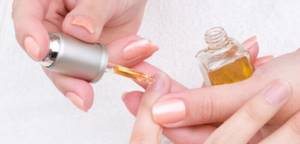
The oil is designed to nourish the skin around the nail with lipids, thickening it, protecting it from moisture loss, exposure to external moisture, and nourishing it with vitamins, minerals and organic acids. A few good brands:
- Eveline Cosmetics Nail Therapy Professional Polish-made nail and cuticle oil, mass market, affordable price and excellent quality. Eveline oil helps not only with daily care, but also for treating inflammation and infections of the skin around the nail. The formula contains vitamins, mineral components, almond oil. Has a pleasant fruity smell. Claimed to be a nourishing agent for cuticles and nails.
- Naomi Cuticle Oil

Floral cuticle oil. You can choose aromas of lavender, vanilla, almond, orange, rose, lemon, grape seed, coconut, jojoba, apricot, lily and marula. Manufacturer – USA. Volume 15 ml. In addition to oils, it contains vitamins and minerals. Moisturizes, nourishes, and has a pleasant relaxing aroma.
- TNL cuticle oil
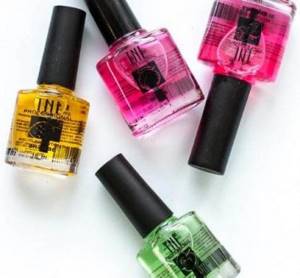
Flavors – strawberry, peach, pineapple, lemon, apple, cherry. Contains vitamins E and F. The oil can be purchased in both bottle and pencil format for ease of application. The products have a softening, nourishing and anti-inflammatory effect in case of hangnails. With prolonged use, the skin around the nail thickens and its growth rate slows down. Volume – 10 ml. Manufacturer: Russia; part of the line is produced in South Korea.
Treatment of injured cuticle
Unsuccessful removal of the cuticle brings certain injuries. Or they appear for any other reason, including diseases. To solve this problem, any specialist will advise you to try edged manicure. A bad solution is a hardware manicure. The answer is simple: the cutter can further injure the already damaged skin.
If there are open wounds, an antiseptic is applied to the area around the nail. Then the cuticle along with the burrs is removed with scissors. For better healing, use natural cuticle oil. Before choosing a product, it is advisable to read the composition; it must contain vitamins. These oils are ideal for those with sensitive skin.
After a manicure, you should visit a dermatologist who will prescribe the right treatment that can relieve many problems with damaged cuticles.
Oil pencil
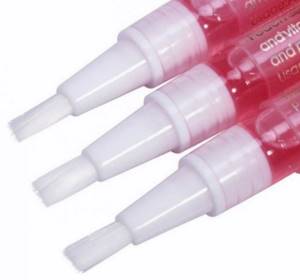
It is still the same product as regular oil, but in a convenient format for daily use “on the run”. You can carry it in your purse or cosmetic bag, or take it on trips. At the end of such a pencil there is a convenient applicator or brush, through which the oil reaches the cuticle precisely. Let's look at a few popular ones:
- OPI Cuticle Oil in pencil
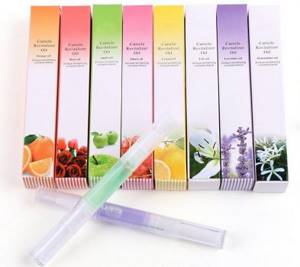
The manufacturer's line of oils includes 12 types of aromas. The product is easy to apply, quickly absorbed, softens and nourishes the skin around the nail. Volume – 5 ml. Economical.
- Color Intense cuticle oil stick with tea tree In the same series you can choose products with oils of peach, grape seed, freesia, orange, etc. The bottle has a comfortable brush with soft bristles. Has a pleasant aroma. It is based on almond, marula and sunflower oil, kelp extract, tocopherol/vitamin E. It has an antibacterial effect and heals hangnails.
- RuNail oil pencil
The line includes more than 10 scents to choose from. Economical product. Volume – 5 ml. Often comes in sets of 3 pieces. Nourishes and strengthens nails and cuticles. The applicator is a brush with soft bristles. It has a pleasant aroma and thick oil consistency.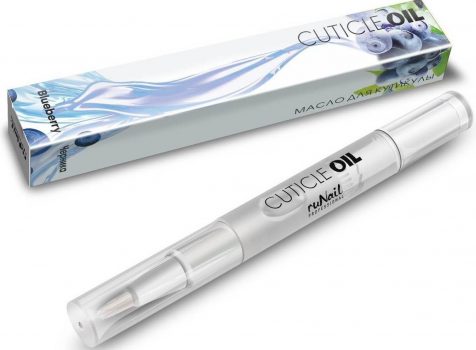
All about choosing and using nail and cuticle oil
How to work correctly with different types of cuticles
The cuticle on the nails (photos of its various types are presented below) requires an individual approach when processing and removing.
This is due to many factors:
- different types of skin and its properties;
- presence of injuries;
- individual client preferences;
- type of materials used for subsequent coating.
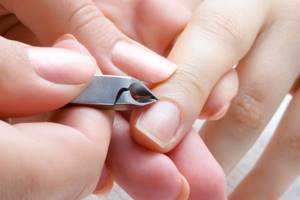
To select a manicure taking into account the type of cuticle, you can use the following table:
| Type of cuticle | Suitable manicure technique | Note |
| Dry |
| If there are burrs in the area of the sinuses and side ridges, it is recommended to use a cutting tool. |
| Wet |
| For hyperhidrosis, the use of the device is recommended only for experienced professionals. |
| Thinned | All techniques | In the absence of overgrown cuticles and keratinization, the most gentle option is a European manicure. |
| Tight cuticle |
| If you do not have sufficient experience in removing cuticles using hardware techniques, it is recommended to use cuticle cutters or scissors. |
Dry cuticle
This type of cuticle dries out as it grows, forming a pronounced whitish stratum corneum. Often, under tension or mechanical stress, small tears occur, which subsequently form burrs.
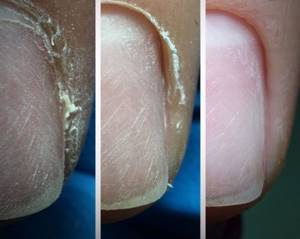
As a rule, dry cuticle is accompanied by hyperkeratosis of the lateral ridges, which can only be properly processed using hardware technology. Correctly selected cutter abrasive and the correct direction allows you to grind off burrs without giving them the opportunity to increase in size.
The big advantage of the hardware technique is that with its constant use, most clients experience a decrease in the growth of the cuticle and the appearance of roughness on the rollers.
Wet cuticle
Previously, it was believed that the hardware technique was not suitable for hyperhidrotic hands. Wet skin particles tend to clog the cutter, and with strong pressure the abrasive caused discomfort and burning.
That is why for a long time the classic trimming technique was used to process and remove wet cuticles. Wet hands in most cases have thin skin without compactions in the area of the side rollers. Therefore, it is quite enough to treat them with a soft file before soaking.
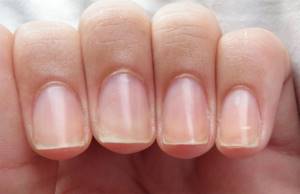
However, the advent of polymers and gel varnish systems eliminated the possibility of using liquids before coating. This factor gave impetus to the development of hardware manicure techniques that allow working with wet cuticles.
Thin cuticle
There are several reasons for thinning cuticles:
- physiological;
- traumatic;
- mechanical.
For those with thin cuticles, a European manicure is enough to give them a well-groomed look.
Using a device or cutting tool on thin cuticles, there is always a risk of injury. As a rule, the growth zone on such hands is quite close, which excludes the possibility of performing a deep manicure.
Tight cuticle
The cuticle on the nails (photos before and after removal show the difference) can have a dense and elastic structure. For an inexperienced technician, removing it using clean hardware can be difficult. Given its peculiarity, a coarser abrasive or a higher rotation speed of the cutter may be required.
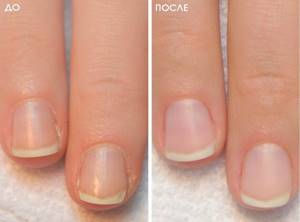
Before and after treatment of cuticles on nails.
The basis of any manicure is not the demonstration of mastery of the instrument, but the performance of a manicure without the risk of injury. Therefore, combined technology is very popular. It involves treating the sinuses and cuticle using a device, and using cutting tools to remove the cuticle.
Serums
A cuticle serum is a concentrated version of nutrients and moisturizers to care for your nails and the skin around them.
Most often it has a liquid or gel texture. Apply with a brush or applicator. Let's look at a few popular options:
- Belweder . A natural, concentrated nail and cuticle serum that simultaneously strengthens and repairs nails, while also helping to moisturize cuticles, prevent hangnails, and make skin softer and more pliable. An excellent product for caring for cuticles at home;

- Solomeya . Solomeya cuticle serum is presented in a convenient pencil format. With regular use twice a day, it makes the cuticle smooth and also prevents the formation of hangnails. Contains oils – jojoba, macadamia, and linoleic acid;
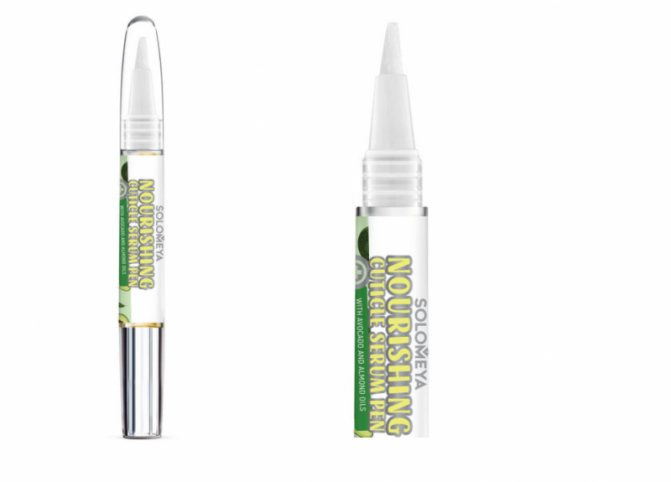
- Serum Aflofarm Regenerum — professional medical cosmetics made in Poland. Contains a complex of essential oils, vitamins and minerals. Intensively nourishes, moisturizes, restores the structure of the nail and protects the cuticle from external factors. Volume – 5 ml.

- Bio-serum Sante Nail&Cuticle Serum “Ultra-nutrition” Manufacturer – Germany. Volume – 10 ml. Organic bio-serum for maximum intensive nutrition. Contains the active substances of aloe vera, physalis, carambola. Safe to use for allergy sufferers.
- Eveline Intensive Moisturizing Serum with Aloe Vera Has a gel consistency. Easy to apply with an applicator brush and does not leave a sticky film. Intensively nourishes and moisturizes the skin, gives nails a natural shine. Manufacturer – Poland. Volume – 8 ml.
Prevention of inflammatory processes on the hand near the nail plate
To prevent such a minor, but very unpleasant inflammation of the cuticle and finger, it is enough to follow simple preventive measures:
- Constant adherence to hygiene rules. Hangnails on and around the nails should not be picked off or bitten off. If the cuticle is still damaged, do not forget to treat the wound with an antiseptic.
- If you have problematic, dry skin or have worked with household chemicals, do not forget to take care of your skin. Use softening creams.
- When performing various tasks around the house or in the garden, protect your hands with special household gloves.
- Get your manicure done only by professional nail technicians who process the tool in a timely manner. If you take care of your nails yourself, also do not forget to sterilize all instruments in a timely manner, do not rely on chance, consult with the masters on how they sterilize their instruments.
Reference. In order for your cuticle to always be healthy and well-groomed, when performing a manicure you need to remove not all of it, but only dead cells.
An overgrown cuticle can cause many problems for your beauty. It changes the shape of the nails and stripes appear on the nails. There are several ways to remove dead cuticles.
Classic way
Here the cuticle is trimmed with manicure tools - various scissors and tweezers:

- During this procedure, the hands are treated with a disinfectant, then the nails are shaped. This must be done before soaking, so as not to damage the nail when filing and to avoid delamination.
- Then a bath with warm water is prepared. You can add medicinal salt, herbal decoction or softening gel to the water. For fragrance, add a few drops of your favorite aromatic essential oils. You need to hold your hands in this bath for about seven minutes.
- After that, do not forget to remove the remaining polish or gel polish from the nails.
- After which the cuticle is removed with tweezers or scissors. This is a very important part of the procedure, so you should not save on tools by buying the lowest quality and cheapest; preference should be given to stainless steel tools with manual sharpening of the cutting surface.
- Next, very carefully push the cuticle with a pusher tool from the edge of the nail to its middle.
- We use a special file to clean the pterygium (this is what manicurists call the barely visible layer of cuticle on the nail plate). Be careful not to scratch your nail when performing these operations.
- Then trim off the keratinized pieces of skin around the nail, try to remove the cuticle in one piece, then you won’t get hangnails.
- At the end of the procedure, apply nail care cream or oil to the cuticles.
The undoubted advantage of this method is the ability to get well-groomed nails in the shortest possible time. The disadvantages are that more cuticles are removed than necessary, which can increase the risk of infection, and after the procedure itself, the cuticle grows more quickly, becomes tougher and creates problems with further removal.
The following video shows all the stages of a classic manicure:
No trim manicure
In general, it is similar to the classic method of removing cuticles, with the only difference that instead of tweezers or scissors, chemicals based on alkali or acids are used to remove it. They are also called “keratolics”. Keratolytics help soften the cuticle, after which it is moved using a special “orange stick”.
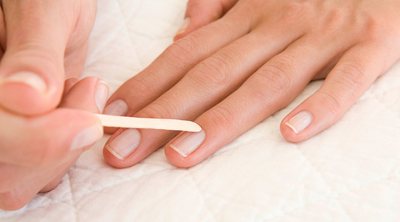
a trimless manicure can also be called “dry”. This manicure ends in the same way as a classic one, by applying care products to the nail plate and finger.
There are many more advantages to this method, the safety for the health of the finger is much higher, the skin is not injured and, most importantly, only dead parts of the cuticle are removed!
Important! However, it is difficult to immediately switch to a trimless manicure from a classic one; several intermediate procedures will be required to prepare the cuticle.
The video below shows how an unedged manicure is done:
Brazilian
It is also a branch of the classic manicure with the difference that a nail file is used instead of cutting tweezers or scissors. And to moisturize the skin, use special moistened gloves soaked in a fortified composition. These gloves are used to massage the fingers, then a softening cream is rubbed in with them, and then the cuticle is pushed back with a special stick and treated with a nail file.
This method is good because it eliminates the risk of infection, the skin is not injured, and thanks to the fortified impregnation of the gloves, the skin is saturated with useful minerals and vitamins. They mainly remove keratinized areas of the cuticle and skin, preserving the living ones. Well, during the procedure it smells pleasantly of herbs and fruits. And you don’t have to use an expensive tool.
Among the disadvantages is that such a Brazilian manicure will not help in particularly difficult situations and neglect, and to carry it out you need to buy special kits.
All stages of Brazilian manicure can be seen in the video:
Hardware
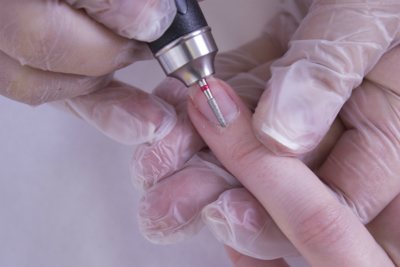
The method is high-tech, which does not require pre-softening and preparing the skin; only dead cells are removed, while living ones continue to protect the nail. However, this manicure is inconvenient because it cannot be done at home; it is done only in special nail salons.
All the nuances of this procedure are shown in the video:
Solar
Attention! One of the most fashionable and latest innovations. This method is very useful for the cuticle itself, and it can be done at home.
For this purpose, a special preparation is purchased, which contains various salts and oils from the Dead Sea and its surrounding areas. The role of peeling is performed by medicinal salts, and the oil prepares and moisturizes the skin.
- To carry out a solar manicure, first the hands are disinfected, then the drug is applied and a massage is performed with dry hands and then with wet ones. The salts of the drug, under the influence of moisture, penetrate deep into the skin, and a soft peeling is obtained. During this procedure, dead skin cells and cuticles are exfoliated, the pores on the skin open wider, and the oil of the drug penetrates very deeply into the skin.
- Then, for the “sauna effect,” a plastic bag or plastic gloves are put on your hands.
- After about twenty minutes they are removed and the hands are massaged again. In this case, a cream with oils from the Dead Sea is also used. Due to this combined and healing effect, the skin of the fingers is moisturized very deeply, it turns out smooth and very elastic.
Beautiful, well-groomed and healthy fingers and nails say a lot about their owner. Don’t forget to follow simple rules of prevention, and then soft, smooth and healthy fingers will thank you and save you from further hassle with treating inflammation. Remember that even the best manicurist will not be able to make your fingers attractive if you do not take care of your cuticles yourself.
Massage

A massage procedure for nails and cuticles is recommended as an addition to the manicure procedure. It can be performed separately and at home, 2-5 times a week, to improve blood circulation in the fingertips, thereby accelerating nail growth and tidying up the condition of the skin.
Performed using oil or cream as a base. This improves glide, and the products penetrate deeper into the cuticle and nail plates.
What oils can I use? Peach, almond, coconut, arnica, tea tree, and shea are suitable. They can also be mixed in equal proportions, a few drops on a palette or foil.
Recommended sequence of massage movements:
- After performing a manicure or at any convenient time, apply 1 drop of oil to the skin around each finger;
- Using gentle circular movements, massage the skin around the cuticle, slightly “hammering” the product under the skin;
- We squeeze the index and middle fingers of the second hand (if we do it for ourselves) into a lock and “grab” the finger with the first phalanges. We perform circular massage movements from the first to the third phalanx, as if sliding gradually. So we warm up the whole hand. Relieve tension in fingers;
- Using your thumb and index finger, squeeze the tip of your finger with the nail of your second hand every 3 seconds. Let go, repeat. This promotes blood flow to the fingertips and cuticle skin.
- Perform all movements in a complex. After the massage, apply nourishing cream to the entire area of the hands.
Types of hand massage with instructions
Causes of inflammation
The inflammatory process of the cuticle is characterized by redness, swelling, and in severe cases, pus, unpleasant odor and pain.
The reasons that provoke inflammation of the cuticle include:
- Presence of burrs. If you tear them off, process them incorrectly, or do a manicure with non-sterile instruments, then problems are guaranteed.
- Unhealthy cuticle that is too thin or overgrown, dry, flaky, processed with damage to tissue integrity.
- Microorganisms and fungal infections that have entered the tissue.
- Mechanical damage in the form of blows, cuts.
The fold of skin that surrounds the nail plate is called the cuticle. Epithelial cells participate in its formation. These cells are gradually renewed. The cuticle is an important anatomical element that protects the inner surface of the nail from various damages.
Inflammation of the cuticle can occur for various reasons.
- This is often caused by various traumatic injuries. For example, it often happens that the cuticle becomes inflamed after a manicure. Treating the cuticle with untreated tools can also cause it to fester. If the inflammation is severe enough, it can even lead to the formation of an abscess.

The cuticle can become inflamed not only on the fingers, but also on the toes. This often results from a poorly performed pedicure. It is very important that this procedure is carried out only with instruments that have been thoroughly disinfected. It is quite easy to damage the cuticle; it only takes a couple of careless movements. That is why it is very important that the pedicure is performed by an experienced specialist.
- The bad habit of biting your nails also leads to cuticle damage. It usually appears in childhood. So, some people, when nervous, begin to bite their nails, which leads to damage to the cuticle. In this case, many parents make many different attempts in order to save the baby from this.

As a rule, they begin to lubricate the baby's fingers with various substances that have a bitter taste. However, this method is not suitable for removing a bad habit. In this case, it is better to show the child to a psychologist. In this situation, qualified specialist work is required in order to teach the child to deal with stress.
- Inadequate nail care is another factor that can lead to cuticle damage. So, if these areas are not treated with special products, they can subsequently become very dry. In order to get rid of severe dryness, you should lubricate the cuticle with special oils or creams. These products nourish dry skin, which helps it look better.

Baths
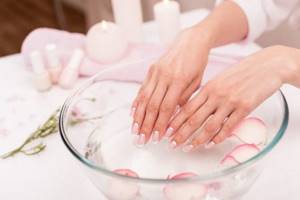
Cuticle baths are part of a salon manicure and SPA hand care procedure. They can also be performed at home using related products or special cosmetics. The purpose of the bath may vary depending on the components used, but the primary goal is to moisturize, soften the skin and relieve tension from the hands.
Warm water, soap or shower gel, aroma oils, iodine, sea salt, herbal extracts, homemade decoctions and tinctures are used. A few homemade recipes to note:
With sea salt and aroma oil
Any version of sea salt will do, both regular and with additives. For 1 liter of warm water, 1 tablespoon of product and 3-5 drops of oil. We immerse our hands for 15 minutes. Before the bath, it will be useful to do a light massage, after which the water will relieve any remaining tension from the joints.
With decoction or tincture of medicinal herbs
Pour 2-3 tablespoons of chamomile, mint, plantain or sage flowers into 1 liter of hot water. Let it brew for 15 minutes, and then immerse your hands for 15 - 20 minutes. You can also add peach, shea butter, lavender, tea tree, apricot, coconut or almond oil.
After the bath, lubricate your hands generously with care cream or oil. Instead of dried flowers, you can use ready-made tinctures of chamomile, sage, calendula, plantain, buy them at the pharmacy.
For redness and peeling
If they are caused by dry skin on your hands, then a milk bath will help. Mix 1 liter of warm milk with 1 tbsp. olive, sunflower, flaxseed, almond, apricot, rose or peach oil to choose from. We immerse our hands for 20 minutes, and then rinse with warm water and apply an intensely nourishing cream. If redness is caused by an allergy, it is necessary to identify the allergen and use medicinal cosmetics.
Hand baths: 30 recipes for different purposes
Treatment of inflamed cuticle
Depending on the nature of the cause that caused the inflammation, treatment methods are determined.
Only a doctor can treat a cuticle affected by a fungus, because self-medication may not only worsen the skin condition, but also cause problems with nails. In addition, with a severe infection, a course of antibiotics is sometimes indicated. And any medications can only be taken as prescribed by a doctor.
With flaky cuticles, an important point for treatment is the absence of trimmed manicure. It is after this that the skin dries out and cuts appear, opening access to infections. The most correct solution is to do a non-edged manicure, in which the cuticle is carefully pushed back with a special stick. After any nail care procedures or household work, it is necessary to moisturize the skin around the nails with lotions and creams. And do housework exclusively with gloves.
At the first signs of inflammation around the nail, you should thoroughly wash and dry your hands. If there is pus, it should be removed by light pressure if it is not deep, or compresses should be made using the pulp of aloe leaves to draw it out. Baths with a strong saline solution (white vinegar, Epsom salts) or the use of special ointments will also help. After removing the pus, the wound is disinfected with hydrogen peroxide, cauterized with iodine and covered with a bandage.
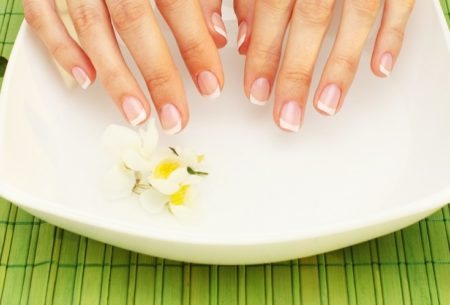
You can treat the cuticle after cleansing from suppuration or with minor inflammation around the nail at home or by contacting a specialist. Essential oils are the most popular means for caring and treating the skin around the nails. The most effective are grapefruit, apricot and castor oils. If you do the procedures regularly, the inflammation will go away in a short time, and the nails and skin will become elastic.
To eliminate inflammation and improve the condition of the cuticle you need to:
- Apply lavender oil around the nail area. It is they that are best used to treat inflamed tissues, as it is a powerful antiseptic.
- Apply an ointment consisting of calendula flowers and petroleum jelly. For 0.5 cups of dry matter, take 10 grams of Vaseline. After heating in a water bath, the mixture must be infused for 10-12 hours. Then place in a convenient container, after straining.
- Rub the inside of the grapefruit peel. Thus, the cuticle can not only be disinfected, but also nourished with vitamins.
- To eliminate dying cells, rub cornmeal into wet fingers once every seven days. This natural scrub is great for cleansing.
Cuticle inflammation can be treated in several ways. First you need to get rid of unpleasant and painful sensations, as well as cure inflammation and purulent abscesses. This can be done with the help of anti-inflammatory drugs - ointments, gels. Among folk methods, baths with oak bark, chamomile, and calendula are considered the most effective. They not only eliminate redness and inflammation, swelling, but also help speed up the process of tissue regeneration.
If the cuticle on your toes turns black, you should give your feet a bath with soda or laundry soap - safe products that will remove all dirt from the skin. The cause of blackening may be dirt getting under the thin layer of cuticle. Also, part of the nail may turn black due to bumps and bruises, which are clearly visible on the delicate skin. When pressing on the damaged area, the patient will feel slight discomfort, but it will come from the nail rather than from the cuticle. The same applies to minor injuries to the lower part of the nail, high pressure and mechanical stress.
If the cuticle is moving away from the nail and is very swollen, before moving on to treatment, you need to find the cause of the inflammation. To treat fungal infections, you should use medications aimed at eliminating fungal bacteria. If you experience an allergic reaction to manicure products, creams, lotions and household chemicals, you will have to take a course of allergy medications. In especially severe cases - antibiotics.
In order for wounds on the cuticle to heal as quickly as possible, they should be regularly treated with an alcohol solution, which has disinfectant properties.
Pharmacy products
Pharmacy products are more effective in relieving inflammation and removing ulcers and cuticle redness. Their main task is to relieve the patient from redness and pain. All medications must be prescribed by a specialist. Before purchasing them, it is important to make sure that the cause of the inflammatory process is not an allergic reaction - then the treatment will be different.
Drugs that will help eliminate abscesses with purulent discharge are:
- Vishnevsky ointment. A universal anti-inflammatory agent. Its main task is to remove all the dirt along with pus from the wound, and then allow the cuticle to heal peacefully.
- Ichthyol ointment. Based on it, you can prepare a night compress for the affected area. A small amount of ichthyol ointment is applied to a cotton pad or a piece of cotton folded several times, after which the compress is tightly applied to the inflamed area and secured with an adhesive plaster or a tight bandage. It is better to carry out the procedure in the evening so that the bandage remains in place all night and does not interfere with your usual activities.
If the finger around the nail is swollen, first you need to treat it with a disinfectant and only then proceed to create a compress or bandage for the night.
Treatment at home
Traditional medicine is suitable for treatment at home. A paste based on aloe vera or plantain is good for relieving inflammation. It is also applied to a cotton pad or gauze, after which it is fixed on the affected area and left there overnight.
The pulp can be replaced with fresh shoots of aloe vera or plantain, which have the same effect and are good at drawing out pus. Aloe has excellent healing properties. The plant will not only draw out all the pus from the wound, but will also promote its speedy healing.
A nail bath with soda or various oils will help get rid of itching and redness. The main thing is that the ingredients did not cause an allergic reaction, which could provoke a new wave of inflammation. If there are small cracks and scratches on the cuticle, it is better to avoid using soda, as it can cause irritation and pain.
Masks

Masks make it possible to quickly get your hands and cuticles in order at home. You can also purchase ready-made disposable hand masks with active ingredients. It is convenient not to apply masks to your hands, but to fill disposable plastic gloves or bags with them, then immerse your hand there for the recommended time, and dispose of them after use. Several recipes with different directions of action:
Brightening and nourishing
Boil the potatoes and mash them while still warm with a fork. Add the juice of half a lemon to it and mix. Fill the glove or bag, immerse your hands for 15 minutes and wrap them in warmth. Afterwards, rinse off and apply moisturizer.
Intensely moisturizing
Grate 1 cucumber and mix with aloe vera pulp from a piece of leaf about 2-3 cm. Stir, knead, and fill a bag or glove. We immerse our hands for 15 minutes. Afterwards, rinse your hands with warm water and apply nourishing cream.
Nutritious
Pour 3-4 tablespoons of finely ground oatmeal with 300-400 ml of hot water. Leave for 5-8 minutes, and then add 2 tablespoons of plain yogurt. Fill the bag or gloves and immerse your hands for 15-20 minutes. Wrap up in warmth. Afterwards, rinse with warm water and apply cream.
Hand masks: 30 homemade recipes
How to remove dry cuticle?
Dry cuticles are often very problematic. Due to excessive dryness, this part of the nail can no longer provide one hundred percent protection to the entire nail plate. Promotes the appearance of burrs.
The master needs to take care of the dry cuticle; it is worth refusing to trim the manicure so as not to damage the thinnest skin. The capillaries in the dry cuticle are located close to each other, so blood will flow quickly. You can get an infection.
The right solution would be a hardware manicure. The main thing is to choose the right cutter, then the keratinized skin can be carefully sanded rather than cut off. After processing, the skin is treated with special jojoba or almond oil. A moisturizer will do. The main rule is to try not to come into contact with chemicals and hard water, especially without gloves. Otherwise, this may again lead to dry skin.
Paraffin therapy

Paraffin therapy is an express method for the fastest possible restoration of hand skin and cuticles.
You can perform the hot procedure at home or in the salon if you have a bath. The second option, more convenient and economical for use both in the salon and at home, is cold paraffin therapy.
Cold paraffin therapy: procedure
- It is performed using a special cream paraffin.
Paraffin for hot and cold paraffin therapy - review of the best - Before the procedure, hands are cleansed, scrubbed, nourishing cream, oil or serum is applied, followed by cream-paraffin in a thick layer.
- Everything is wrapped in plastic and warm mittens or a towel of your choice.
- After 20-30 minutes, remove the polyethylene, wipe off the remaining paraffin with a napkin and apply a care cream.
- Hands are transformed, and the cuticle looks well-groomed and neat.
- The procedure can be performed once a week to maintain well-groomed skin.
Removing wet cuticle
Wet cuticle is very elastic and must be removed carefully, otherwise it may tear. For this type of cuticle, a combined manicure would be the ideal choice. It is dried before removal. After this, a pusher is taken, and the leathery part is moved away with the help of a pusher.
As for the pterygium, it is cleaned with a milling cutter. This is done so that the cuticle is raised. In this case, it is easier to cut it with scissors designed specifically for manicure. After this treatment, the side rollers and the cuticle itself must be sanded using a cutter. A soft corundum nozzle is used.
Prevention and treatment of hangnails

Preventing hangnails is better than treating them. How to do it:
- It is necessary to regularly use the cream after contact with water, and use cuticle oil in the morning and evening. This will keep the skin moisturized, it will not crack, and the risk of injury will be minimized.
- The second prevention option is regular European, unedged manicure. It consists of applying an emollient or remover to the cuticle, removing or pushing back the cuticle with an orange stick or pusher, and then applying oil or nourishing cream. If you perform this procedure 2 times a week, you will no longer need a trimmed manicure.
- The third prevention option is systemic dry treatment of the skin around the nail with a cuticle file. After the procedure, apply oil or nourishing cream.
If the cuticle is in a state of disrepair, then before the European manicure it is necessary to perform a hardware or trimmed manicure, and then move on to an untrimmed one.
What to do if hangnails appear on the skin, and even become inflamed due to bacteria or microbes getting into the wound? In this case, it is necessary to carefully cut the skin with scissors or forceps and apply antiseptic oil.
Instead of oil, you can use Sudocrem, ointment with silver, Rescue balm, tea tree oil. It is necessary to nourish and moisturize the skin in the wound area every day until the inflammation goes away and everything heals.
How to get rid of hangnails - remedies and procedures
Why does the cuticle grow quickly after a hardware manicure?
Among women, deep manicures have recently become quite popular, during which a flame cutter is inserted into the subcuticle space, followed by skin removal. A deep manicure involves removing small pieces of cuticle that are located inside, under the top part of the skin. The human body does not always respond adequately to such manipulation. Due to the soft matrix, damage is possible, as a result of which the nail grows crooked, sideways or in waves. In addition, cracks may be observed along the nail.
But this is not the only problem that arises as a result of a deep manicure. Very often, due to an incorrectly chosen technique, within a few days after a manicure, the skin begins to peel off severely and grow at a tremendous speed. Thus, just a few days after the procedure, the nails look untidy, sloppy, as if they had not been manicured for several weeks. To prevent this from happening, you need to know a few subtleties and choose the right technique.
Why does the cuticle grow quickly after a hardware manicure:
- It is necessary to choose the correct abrasiveness of the cutter. Some craftsmen, to save time, use cutters with blue notches, which have a large grain size. Delicate skin is susceptible to aggressive influences.
- Another reason for excessively rapid roughening of the skin in the cuticle area is strong pressure and incorrectly selected rotation speed of the cutter. If the cuticle is not raised enough, it cannot be cut off after the first pass with a ball or cylinder. In this case, the master can put pressure on the cutter and increase the speed. This provokes a burning sensation, cuts off not only the cuticle, but also touches the delicate skin that was previously sanded. Thus, the delicate areas around the side bolsters become overly sensitive. This promotes further growth of the cuticle. In this case, the best option is to choose a combined technique and refuse to use cuticle cutters. Also, do not choose an abrasive that is too coarse.

After manicure
How to slow down cuticle growth
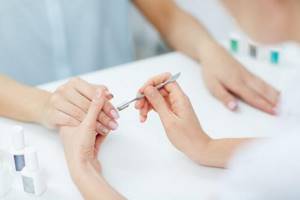
To significantly slow down the growth and renewal of the skin around the nail, it is recommended to apply an emollient or oil to it daily for 2 - 3 weeks, and then push it away with an orange stick or pusher. The cuticle becomes dense and short, we systematically remove dry pterygium by softening, and after the specified time it practically stops growing. It is only necessary to perform maintenance procedures 1-2 times a week.
What methods of caring for cuticles are in your beauty arsenal, what would you recommend as the best product or life hack?
Share with us in the comments. Comment
Treatment
Do not rush to see a doctor immediately; in the initial stages, the cuticle can be cured on your own if the inflammation begins on one finger. If there is inflammation on several fingers at once, you should immediately contact a dermatologist, there is a high probability of infection with a fungus.
Attention! Inflammation in the skin occurs in such a way that to remove purulent discharge, it is enough to lightly press on the sore finger, and the pus will come out.
Before carrying out this procedure, you need to briefly steam your finger in a bath with a solution of potassium permanganate, which has a light pink color. After cleaning and disinfecting the wound, inflammation on the finger can be cured with both folk remedies and medications.
How to treat?
The following medications are recommended to be used:
- Vishnevsky ointment traditionally cures various inflammatory processes on the skin well. It is enough to apply it on a piece of cotton wool or a cotton pad, apply it to the inflamed area, and secure it with an adhesive plaster or bandage. It is optimal to treat the cuticle and finger with ointment before bedtime. Overnight, the ointment will be well absorbed into the skin and will help relieve pain and redness and draw out purulent discharge.
- Ichthyol ointment is used similarly to Vishnevsky ointment and has a similar treatment principle.
- When the abscess at the site of inflammation breaks through, the open wound must be treated with an antiseptic such as hydrogen peroxide or chlorhexidine to prevent the infection from spreading throughout the finger and then apply Miramistin or Levomekol ointment.
Folk remedies
Folk remedies include:
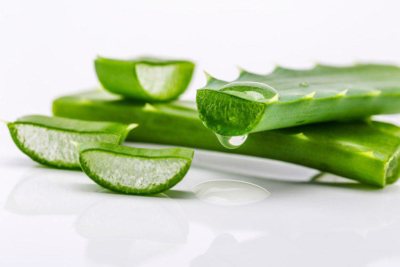
- The most affordable and effective remedy for relieving the symptoms of inflammation is aloe leaf. It needs to be cut lengthwise and a fresh cut applied to the sore side of the finger. A compress based on aloe juice will also help: soak a bandage with it and apply it to the sore spot. Aloe-based creams and oils are slightly less effective.
- You can use the old “grandfather’s recipe”, when part of the bandage is rubbed with damp soap (preferably laundry soap), then sprinkled with salt, after which the bandage is wrapped around the sore spot.
- Baths with infusions of medicinal antiseptic herbs also do a good job of treating inflammation.
A decoction is made from chamomile, oak bark, and calendula in a ratio of one to ten with water. To do this, you need to add the medicinal herb to water, boil it for five minutes, then remove it from the heat and let it brew for about half an hour. Then dip the sore finger into the resulting infusion for ten minutes. - Ointment based on flour and honey. Flour is added to honey until a kind of dough is formed. This piece is applied to the sore spot, wrapped in a bandage and kept for about twelve hours.
- Well, where would we be without plantain! It or sorrel leaves are crushed very finely and similarly applied to the inflammation for six hours.
- Various essential oils can be applied to the inflamed area of the finger about six times a day.
How to paint your nails with regular polish
Paint your nails with a base
Brightly colored polishes will stain your nails, so apply a clear base coat before topping them off with Clockwork Orange. Otherwise, the pleasure from a bright manicure will last for three days, and the bright color will be absorbed into the nail for a long time.
Paint your nails, but give them breaks.
It’s better, of course, to go without polish at all - this way it’s easier to notice any changes on your nails and show them to a specialist. But if you like to paint your nails, then give them a rest at least from time to time.
Dermatologists advise giving your nails a vacation for at least a week, preferably a month. The advice applies to both regular and gel polish. In both cases, the nail becomes trapped under a layer of varnish and does not receive the proper amount of moisture. This can thin it and even destroy it. Toenails have better luck - in winter they are most often left alone and hidden under socks, which is only good for them.
